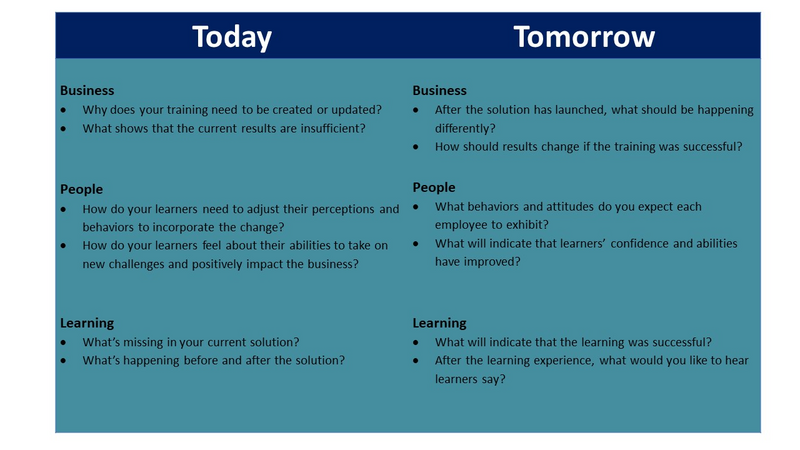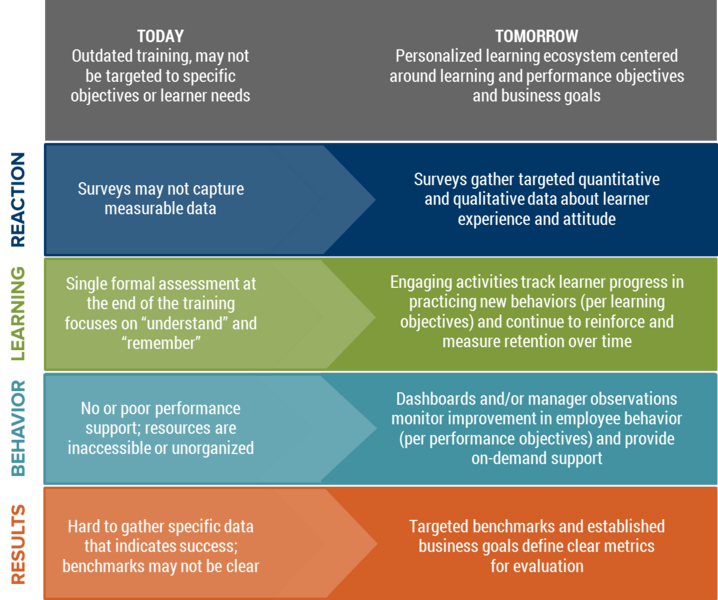ATD Blog
Is Your Training Effective?
Wed Jun 26 2019

Measuring and evaluating the impact of your learning solution is much easier said than done. So how do you start? This article will cover best practices, from benchmarks and design to useful tools for applying Kirkpatrick’s levels of evaluation.
Start Early, Start Now: Discover Business Context
Do you have a clear picture of what’s going on now and what needs to change? By framing questions around your business, your learners, and the current learning landscape, you can better see the connections between them and ensure your learning solution is aligned with your vision for success.
Your business context can be used to develop a performance map that helps establish measurable and observable metrics for evaluating performance and skill transfer. To discover your business context, first consider the following example questions:

Once you’ve answered similar questions, it’s time to set your benchmarks for your business goals. Start at the lowest reasonable rate as training is only one part of the big picture. Here are some:
Increase annual sales by 10 percent by landing three new accounts each month.
Accelerate time to proficiency from eight months to three months.
Next, consider how people need to transform their behaviors over time to help the business achieve those results. These will be your performance objectives, much like the examples below:
As a result of this training, new hires will successfully implement all allergen-handling procedures to reduce contamination to acceptable standards.
In customer interactions, sales reps will adequately overcome objections and persuade customers to buy company products.
Finally, think about what type of learning experience will help your learners with the transformation. Establish learning objectives that measure how learners will practice expected behaviors, such as:
In scenarios that illustrate the most common safety errors, learners select appropriate steps to prevent or correct each error.
In preparation for a customer meeting, learners analyze the customer’s situation to recommend a product that aligns with the customer’s needs.
The foundation you establish equips you to effectively measure learner progress within the defined levels of Reaction, Learning, Behavior, and Results.
1. Reaction: Listen to the Voices Around You
The simplest—yet often most overlooked—way to measure learners’ attitudes toward learning is to ask them how they felt. Post-learning surveys can be a great way to gather insight into what worked well and what didn’t. Although surveys are only one method of gauging learner reaction, all strategies should evaluate whether the learning was relatable and practical. You should also assess learners’ confidence and how their personal outlook may have shifted during (and after) their experience.
2. Learning: Set the Stage, Gather the Numbers, and Follow Up
Immersive learning experiences can engage learners and encourage them to think about real-world application. Personalized, interactive activities designed around measurable learning objectives put learners in the driver’s seat and transfer learning into the real world. Include resources during and after the learning experience to ensure that your learners feel supported and remain on track. Implement a process for re-evaluation at 30, 60, and 90 days to measure the retention over time.
If your solution is digital and has data tracking, periodically review the fine print. Which questions are learners missing most often? How frequently are they accessing resources? If your learning experience is optional, what is your completion rate? In classroom settings, have the facilitator consider which sections learners appear to feel most confident about or have trouble with.
3. Behavior: Committing to and Applying the New Standard
Performance objectives can allow you to see if your learners are doing what they need to be doing, at the right time, in the right way. You can use performance dashboards or direct manager support to evaluate how behavior may have changed six months, 12 months, and 18 months after training. Incorporate performance reviews to not only provide proactive feedback and support but also continue gauging your learners’ reactions and confidence as they grow.
4. Results: Equations That Matter
Finally, use the business goals and benchmarks you set to find out whether you’re meeting your vision for success. If one of your goals was to improve resolution times to customer complaints, on average, how quickly are customer complaints being addressed now compared to eight to 12 months ago? If timing has improved, your solution is working! If not, consider where adjustments can be made. Sometimes you may even need to scale your solution to keep up with evolving times and technologies.
As you commit to a foundation of support, continuous learning, and learner engagement, you can keep your business future-focused and driving toward success.
The table below illustrates how this approach can be used to design a measurable, evaluable solution that’s right for you.

